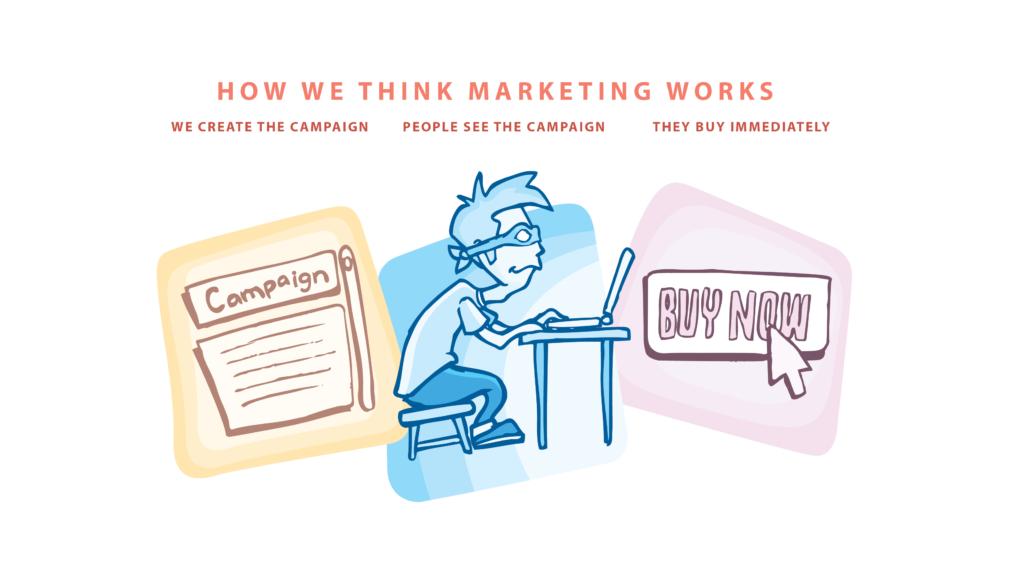Play the long game
Software companies often focus too much on getting people to purchase right now, and miss out on the long game. To succeed, marketers need to figure out their customer's journey.
How does someone become a customer?
Back in 2012, I was a Product Manager for a web-based SaaS. I convinced the team that we should use Sprintly to manage our development process. It changed the way we worked: for the first time, everybody on the team knew what was in progress and what was ready to ship. I’ve been a huge believer in Sprintly ever since.
But how did that happen? How does someone go from not hearing about a product to buying it?
How marketing actually works
Rand Fishkin recently reminded me of something I've felt for a long time: our view of the buying process is completely skewed.
Too often, we think about marketing like this:

When, in reality, it's a much longer series of events. The timeline looks more like this:

(I explored this idea in a Ninja Turtles post, here)
The long funnel
Marketers need to start thinking about the long funnel.

I was recently in San Francisco and went for coffee with Hiten Shah and Justin Abrahms to talk about marketing. I asked Hiten: "What's really working for you guys at Kissmetrics?" I love Hiten's response:
"The better question is: what's already working for you right now? What could you do more of?"
Hiten and Justin asked me to describe how I had discovered Sprint.ly. The more I explained, the more I realized that there were a number of events that lead up to the eventual purchase:
May 2011: the SaaS I was working for decided to adopt Scrum for our team. We hired a consultant to get us started. Soon after, we stopped using Basecamp and started using Pivotal Tracker as our project management tool.
June 2011: My boss saw Joe Stump speak at FOWA about SimpleGeo. He raved about the talk, especially Joe's line: "Starting a business is really, really, really fucking hard."
January 2012: I saw that there was an episode of TWIST with Joe Stump. I'd remembered my boss had liked his talk at FOWA. I listened to it on the way to work, and heard about Joe's new company: Sprint.ly. I believe I signed up for a trial account.
February 2012: During this time, the CTO and I were getting frustrated with Scrum. It just didn't seem to fit our team's workflow. I started reading about the benefits and flexibility of the Kanban philosophy.
April 2012: During my Kanban research, I started googling for "kanban project management software". One result that came up: a blog post by Joe Stump about Sprint.ly's digital Kanban board.
May 2012: Pivotal Tracker was getting harder and harder for us to use: again, it just didn't feel like it matched our team's workflow. I invited our CTO to my trial Sprint.ly account, and floated the idea of switching. We decided to use Sprint.ly and Pivotal at the same time, to see if we liked it.
June 2012: The CTO and I decided that we wanted to switch to Sprint.ly. We championed the idea to the rest of the team, sold them on it, and started paying for Sprint.ly.
From first trigger, to purchase, that's a timeline of over a year. Also, there's at least 7 key touch points that lead up to the actual buying decision.
This is what I mean when I say "the long funnel": most purchases are preceded by a series of events. Even when something looks like an impulse purchase, there's often a greater history behind it.
What this means for marketers
Marketing is like golf: we have a long game, and we have a short game.
The short game is the actual conversion: making it easy to sign-up for a trial, giving people a great first experience, and making it easy to upgrade.
But don't forget the long game! The long game is creating as many of these "touch points" as you can: memorable content, users who share their stories, and having positive interactions with the public. This is another reason why building an audience is important: it gives you the opportunity to stay in touch with folks that could become customers.
Hope this is helpful!
Here's some further reading:
Cheers,
Justin Jackson
@mijustin
PS: This post was originally sent to my newsletter list. You can subscribe here.